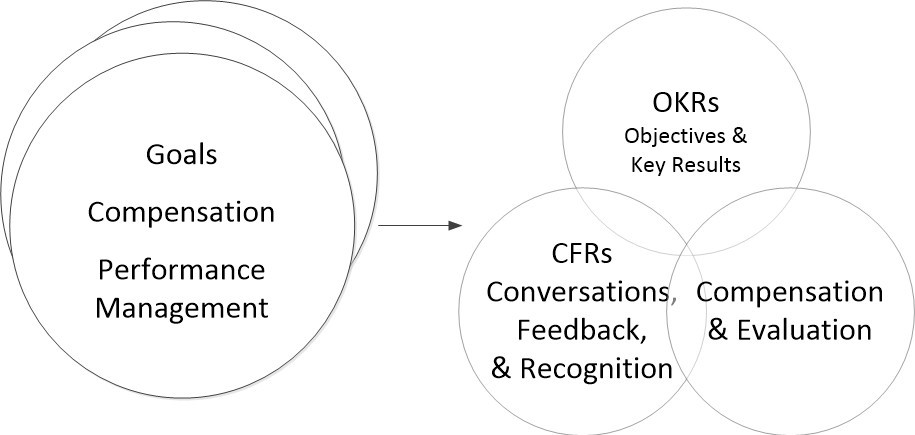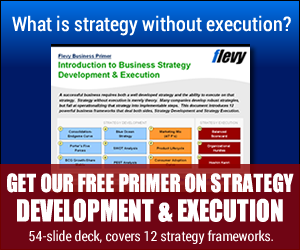The annual performance review is somewhat of an institution in the corporate world, public and not-for-profit organizations, and smaller companies. But it is changing – and project management stands to be a driver in the change.
As the pace of change continues to accelerate, annual review mode of doing business has grown tired and outmoded – and even counter-productive.
The antidote appears to be ‘continuous performance reviews’ implemented through ‘CFRs’ – defined later in the post. This new way of evaluating performance seems much more in sync with the fast pace of change in today’s world – a parallel to the movement from waterfall to agile. It provides a better foundation for building a better performance review process template.
Let’s start by taking a look at annual performance reviews and why there is a better way.
The Old Way: Annual Performance Reviews
 A year is a long time. Goals are achieved. Some goals are forgotten. The landscape changes…and other goals change.
A year is a long time. Goals are achieved. Some goals are forgotten. The landscape changes…and other goals change.
Worse, however, is that goals can become very subjective. People can play games. Performance can go up as end of year approaches – then down after review time.
Goals can be ambitious and challenging…or unambitious and easily achieved. Inconsistency across managers, business areas, and teams can lead to an unhealthy kind of rivalry.
The worst is that performance reviews can simply become out of sync with the facts.
They can therefore become demoralizing to people, and unproductive to organizational goals. While performance justifiably should be tied to performance, how is performance measured, and how often?
Experience shows that stretch goals are helpful and work. Achieving all goals to 100% can easily be an indicator – not of outstanding performance but of inadequate goal setting. Common wisdom shows that setting 3 to 5 – no more, no less – stretch goals is good practice. And setting a relatively short duration such as three months – to keep focus and attention, and allow for change – is more effective than sticking to an annual system that is out of sync with the way the gears are turning everywhere else.
Overview of Continuous Performance Reviews
It seems that a more agile approach to performance reviews is needed. Just as waterfall has yielded in most situations to a more agile – or at least hybrid – approach, the same is needed for performance reviews.

- From annual feedback to continuous feedback: Feedback comes in real time, when things are happening – when it is useful to discuss! Annual requires too much recall after the fact and inevitably leaves things out. And often it is too late and irrelevant to add value at that point.
- From being tied directly to compensation to being largely decoupled from compensation: While compensation clearly needs to be tied to performance, if it is tied too tightly, it enables conflicts in setting the right performance goals. Performance goals are better set with greater objectivity and unfettered by conflicts such as personal compensation.
- From a directing/autocratic approach to a coaching/democratic approach: Employees often fear performance reviews, as they simply feel subject to the wrath of their manager. A more participative, give and take approach eliminates much of that and creates a more transparent, empowered employee.
- From being outcome focused to being process focused: Often we can do out best but do not get achieve what we wanted. We have control of what we do, but often do not have control of the outcome. That’s what is meant by a process focus – work on what you can control, learn from the outcome, and adjust.
- From weakness based to strength based: All too often, performance judgments force a focus on what’s wrong, and less on what is right. Managers may need to justify lower compensation. Whether it is for personal or business aims, the focus needs to be on building, leveraging, and sustaining strengths.
- From being prone to bias to fact driven: Performance reviews for a whole year can be very subjective. Since goals are almost impossible to ‘annualize’, they can be subject to bias that results from separation from the moment – the moment of learning, the moment of impact, the moment of emotion. Facts tied to recent, near real-time events eliminate that.
There is a lot of room for improvement in moving from annual to continuous performance reviews. Since it is a process-based change, let’s look specifically at the processes that change.
Two Sides of a Continuous Performance Review Process
Performance Review necessarily has two components:
- Backward looking – What happened? This has ties to compensation. If the second part was done well continuously throughout the year, this will be much easier.
- Forward looking – What do you want to make happen? This is fluid and is the part to spend the most time on. And it is process-focused – because you have control over what you do, but not necessarily over the outcomes.
Again from the “Measure What Matters” book, here are some useful process-oriented questions:
- What are you working on?
- How are you doing? How are your OKRs coming along?
- Is there anything impeding your work?
- What do you need from me to be (more) successful?
- How do you need to grow to achieve your career goals?
It is apparent from the above that the forward-looking part of the process – the more continuous part – is the most important and where most of the time is spent. It also is much more closely aligned with actually getting things done and achieving organization objectives – than is the performance and compensation review portion.
How Continuous Performance Review Connects to Strategy
In the same way that agile practices tie back to strategy, continuous performance reviews can tie back to strategy through Objectives and Key Results (OKRs).
Conversations, feedback, and recognition (CFR), as described by Peter Doerr, is how the process is transformed to be strategically driven and more agile. CFR is at the core of the continuous performance review process.
Conversations
Conversations need to be one-on-one meetings between employee and manager. With the shared objective to enhance performance, the agenda should be set by the employee. The idea for the manager is to listen, learn, and adjust – through coaching, guiding, and deciding where necessary.
BetterWorks, self-described as experts at “closing the loop between people, strategy, and results”, identified 5 critical focus areas to guide these employee-manager conversations:
- Goal setting and reflection – OKR alignment with strategy and objectives
- Ongoing progress updates – can be very short concentrating on the personal aspect not already stated
- Two-way coaching – enabling employee reach full potential and manager do a better job
- Career growth – skills, growth opportunities, and expanded vision of future roles for the employee
- ‘Lightweight performance review’ – summarizes accomplishments in context of organizational perspective (unrelated to compensation)
The aggregation of these Conversations held throughout the year should make compensation discussions relatively easy and transparent.
Feedback
Feedback, in the words of Sheryl Sandberg, currently the COO of Facebook, is “opinion, grounded in observations and experiences”. In short, it is to hear the impression we make on others.
Unlike an annual review, which tends to be directional from manager to employee, employees today do not just want feedback; they also want to provide feedback to their managers. That is an important adjustment for managers to note.
The two critical aspects for effective feedback are:
- Feedback needs to be specific and associated with detailed facts
- Encourage ‘horizontal feedback- across teams, peers, and departments
Feedback is a cultural issue. It requires management support, and a big part of the objective is to reduce silos.
Recognition
Achievements recognized should be specific, managers need to set goals for specific achievements.
Like with feedback, recognition may require cultural adjustment to achieve. The objective is to think ‘horizontally’ – to create a peer to peer culture on your projects – to facilitate recognition by peers. Here are some ways managers can help this along:
- Encourage story sharing to bring people together
- Make discussions frequent – even at scrum meetings, or regular status meetings
- Tie recognition back to strategy to illustrate impact and reinforce strategic alignment
The following diagram, adapted from “Measure What Matters”, shows visually how the performance evaluation process is transformed from annual to continuous. It also shows where the CFR process fits into the whole picture.
The Goals, Compensation, and Performance Management at left closely overlap into one activity. They represent the old annual performance review, which closely aligns these three elements – with many negative consequences outline above.
This old process becomes one where the elements are much more separated, with minor overlap. Most significant is the separation of Compensation and Evaluation.
PM’s Are Positioned to Create the Performance Review Process Template
—————————————-
I recommend these PM templates (paid link):
—————————————-
Projects are the ideal place to initiate a continuous review process. Consider that projects are:
- Temporary in nature and can provide a great starting point for prototyping
- Executed by smaller and more fluid teams than many other organizational teams
- Are less subject to old organizational structures
- Already using agile practices in most organizations
- Adaptable to new practices such as continuous performance review, which can be implemented across projects
Processes supporting continuous performance review can readily be incorporated into existing project management templates, including templates for project planning and how to execute.
Within a larger organization, a PMO may be in a good position to do this. Smaller organizations can simply pick projects with sufficient flexibility to begin to incorporate these new processes. in both cases, the challenge will be cultural.
Projects can be the conduit for implementing continuous performance reviews throughout the organization, starting small and then proliferating.
—————————————-
I recommend these strategy resources (paid link):
—————————————-


